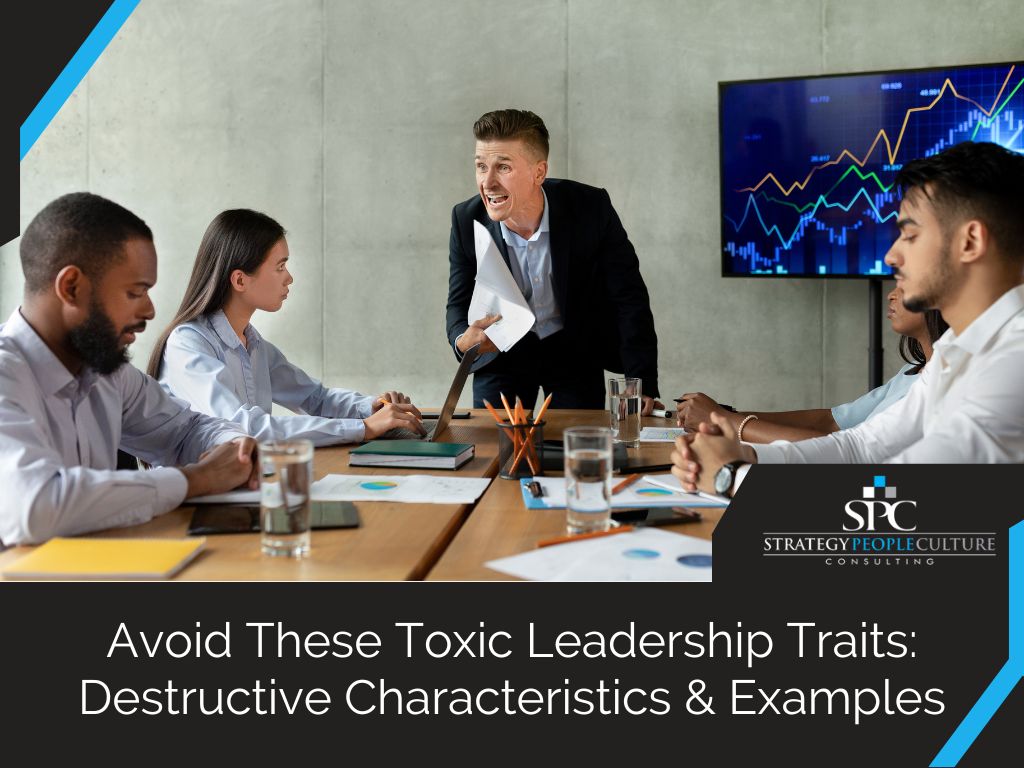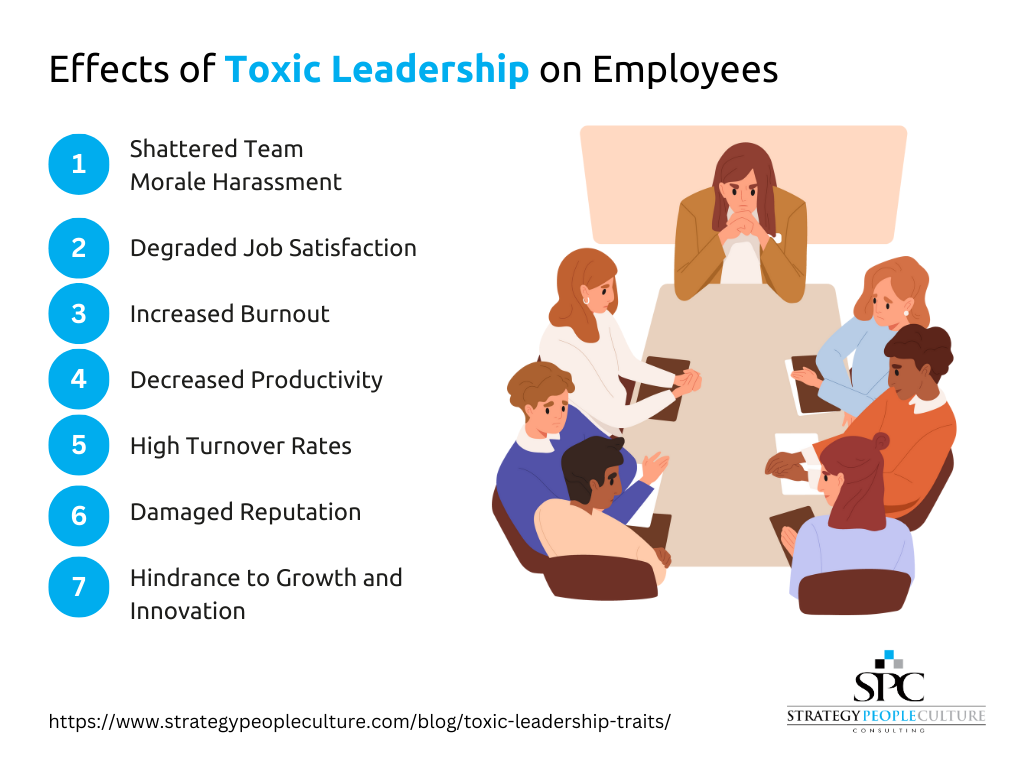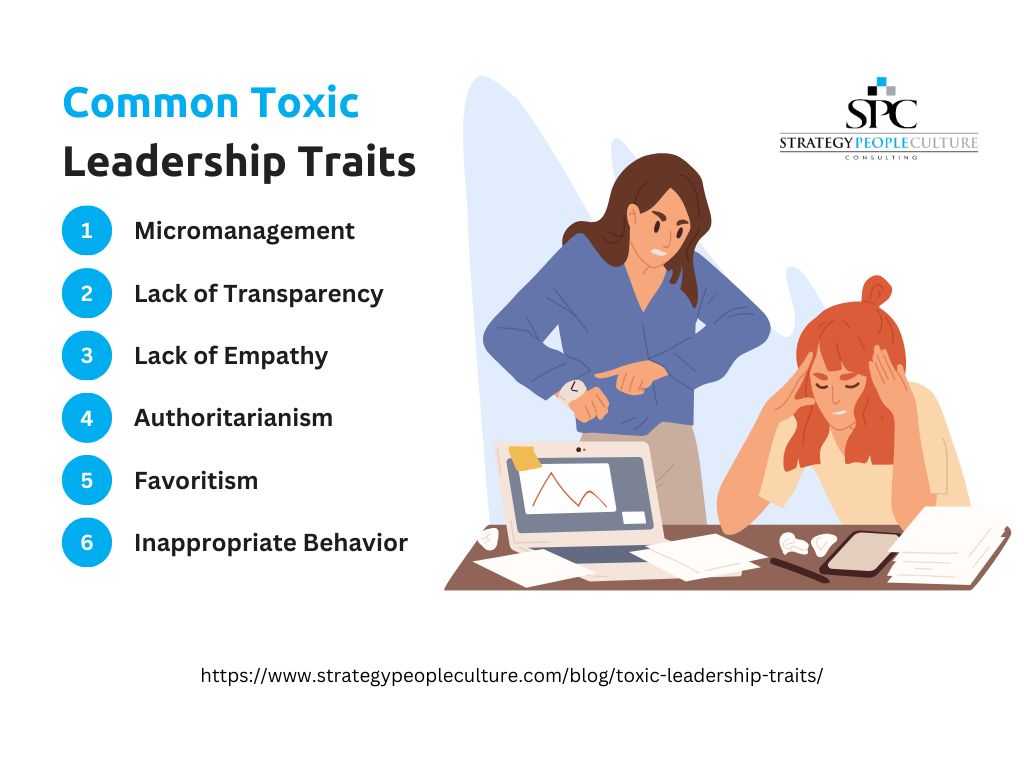Avoid These Toxic Leadership Traits: Destructive Characteristics & Examples

Organizational culture is shaped by its leadership. When led by a healthy, motivating force, organizations thrive, fostering creativity, collaboration, and productivity. However, under toxic leadership, the very foundation of an organization can crumble, leading to disengagement, resentment, and high turnover rates. Recognizing and addressing toxic leadership is a critical element for the well-being and success of the entire organization.
In this article, we will expose some of the most damaging traits of toxic leaders, providing real-world examples to illustrate these characteristics. We will also equip you with actionable strategies to counter these traits. Whether you are a leader or executive seeking self-reflection and improvement, this article will serve as a comprehensive guide. Let’s uncover the dark side of leadership and embark on a journey toward a healthier, more productive organizational culture.
Understanding Toxic Leadership
Toxic leadership, in essence, is characterized by a pattern of behavior that harms individuals and the organization as a whole. These leaders often display traits such as narcissism, manipulation, aggression, and a lack of empathy. They devalue employees, stifle creativity, and breed a culture of fear, mistrust, and resentment. Retaliation in the workplace can also be prevalent, creating an environment of silence and discouragement where employees feel afraid to speak up or report issues.
Remember, recognizing these traits is the first step toward mitigating the harm caused by toxic leadership. Awareness allows us to challenge these behaviors and foster a more positive, healthy, and productive organizational culture.
Deep-Rooted Issues: Rigid Views and Accountability

A major toxic leadership trait is the rigid stance and resistance to change. In today’s rapidly evolving market, inflexibility can be disastrous. Leaders who are unwilling to adapt and evolve, stifle innovation and impede the organization’s growth. For instance, the downfall of Blockbuster, which failed to pivot to the digital age, stands as a stark reminder of the dangers of inflexibility.
Another deeply rooted issue is the inability to accept feedback. Innovation thrives on open dialogue and constructive criticism. Leaders who reject feedback create a stifling environment where employees fear voicing their opinions.
One glaring example of a leader’s inability to accept feedback is the case of Travis Kalanick, the former CEO of Uber. Despite the company’s meteoric rise under his leadership, Kalanick’s tenacious and often combative style led to a toxic work environment rife with controversy and public relations nightmares. One notable incident involved Kalanick arguing with an Uber driver who voiced concerns about pay cuts. Instead of acknowledging the driver’s feedback, Kalanick dismissed his concerns and blamed him for not taking responsibility for his own problems. His inability to accept criticism and make necessary strategic adjustments resulted in a damaged reputation for both himself and Uber, ultimately leading to his resignation.
Consider the case of Xerox Corporation. Known for its photocopiers, Xerox was once at the forefront of technological innovation. The company’s research center, Xerox PARC (Palo Alto Research Center), was responsible for groundbreaking technologies, including the graphical user interface (GUI), Ethernet, and the computer mouse, all of which laid the foundation for personal computing as we know it today. Shockingly, Xerox failed to capitalize on these revolutionary innovations. Instead, these technologies were later picked up by other companies, most notably Apple, which leveraged the GUI and mouse technology for the Lisa and Macintosh computers, setting a new standard for personal computing. This missed opportunity by Xerox can be attributed to the company’s rigid focus on its core business of copiers and printers, a clear demonstration of the lack of strategic vision and adaptability.

Furthermore, a toxic leader often deflects blame and lacks accountability, causing significant damage to the team’s morale and trust. This lack of responsibility from leadership, epitomized by the Volkswagen emission scandal, spreads a culture of dishonesty and short-term focus at the expense of long-term goals and vision.
Fortunately, there is a solution to these issues: Adaptability and Accountability, two key tenets of the Strategy People Culture’s C.A.R.E.TM Model. This model encourages an individual or organization’s ability to be nimble and their willingness to both listen and change. It also emphasizes the importance of holding each other accountable. By adopting these values, leaders can replace toxic traits with a culture that encourages growth, innovation, transparency, and long-term success.
Are you the As**ole in the Room?
The Environment Created by Toxic Leaders for Now and the Future

It’s a harsh question, but one that needs to be asked. A toxic leader often creates an environment filled with fear and intimidation. This hostile atmosphere can significantly hamper employees’ performance, stifling creativity and innovation.
Moreover, this toxic culture can bleed into micromanagement, where leaders excessively control or scrutinize their employees’ work. This approach leads to a lack of autonomy, causing employee frustration and burnout.
Furthermore, inadequate recognition and appreciation of staff can result in high turnover rates.
However, there is hope. The C.A.R.E.TM Model provides a remedy with two of its key tenets: Realness and Enthusiasm. Realness refers to maintaining honesty, genuineness, humility, and trust in leadership. This notion encourages transparent communication and fosters a sense of trust in the workplace. Enthusiasm, on the other hand, is about cultivating a passion for the business, from the organization to individual roles. Adopting these principles can effectively counteract the debilitating effects of toxic leadership and foster a healthy, productive work environment. It’s crucial not just to recognize these toxic leadership traits but to actively combat them by embracing the C.A.R.E.TM Model.
Effects of Toxic Leadership on Employees

The effects of toxic leadership are far-reaching and destructive. Here are some key points to consider:
- Shattered Team Morale: Toxic leaders have a detrimental impact on team morale, creating a negative work environment that demotivates employees.
- Degraded Job Satisfaction: Toxic leaders often undermine the satisfaction and fulfillment that employees derive from their work, leading to decreased job satisfaction.
- Increased Burnout: The toxic behavior of leaders can contribute to employee burnout, as they experience increased stress and exhaustion from dealing with the toxic environment.
- Decreased Productivity: Toxic leadership hampers productivity within the organization, as employees may become disengaged, lose focus, or lack the motivation to perform at their best.
- High Turnover Rates: The presence of toxic leaders often leads to high turnover rates, as employees seek a healthier and more supportive work environment elsewhere.
- Damaged Reputation: Organizations with toxic leaders may develop a negative reputation, making it challenging to attract and retain top talent in the industry.
- Hindrance to Growth and Innovation: The influence of toxic leaders can permeate all levels of the organization, stifling growth and inhibiting innovation, which can have long-lasting impacts.
It is crucial for organizations to address toxic leadership and cultivate a positive and supportive work culture to ensure long-term success and employee well-being.
Common Toxic Leadership Traits

1. Micromanagement
Micromanagement is the excessive control or attention to minor details in task completion or performance. It creates an atmosphere of mistrust, stifling employee creativity and job satisfaction. An infamous example of micromanagement is Steve Jobs, co-founder of Apple, who was known for his hands-on approach and attention to detail, which occasionally bordered on obsessive. Though Jobs ‘ leadership style yielded enviable results, it also created a high-stress environment for employees, leading to burnout and limiting innovation. When Steve Jobs returned to Apple, he decided to change his approach to ultimately leading Apple to new heights.. This shift allowed Apple’s culture to flourish, creating a more supportive environment for innovation.
2. Lack of Transparency
Transparency is integral in leadership, as it builds trust and fosters open communication. Lack of transparency, on the other hand, can lead to a breakdown in team cohesion, reduced morale, and decreased productivity.
3. Lack of Empathy
Empathy allows leaders to understand and share the feelings of their team members, fostering a supportive work culture. Lack of empathy can lead to employee disengagement and high turnover rates. The contrasting leadership styles of Jeff Bezos and Oprah Winfrey are a good illustration; when Bezos has been criticized for Amazon’s harsh work conditions, Certainly, Amazon as a business has been wildly successful, though lack of empathy in this situation cost Amazon money. Winfrey is renowned for her empathetic approach at OWN.
4. Authoritarianism
While a certain degree of authority is necessary for leadership, an overly authoritarian approach can suppress innovative thinking and discourage open dialogue.
5. Favoritism
Playing favorites can corrode team dynamics, lead to conflict, and negatively impact an organization’s culture. It also hinders diversity, inclusion and promotes a sense of unfairness and inequality within the team.
6. Inappropriate Behavior
Inappropriate behavior, such as harassment, discrimination, or bullying, can create a hostile work environment, negatively impacting employee morale and productivity and potentially leading to serious legal consequences for the organization. In 2019, McDonald’s CEO Steve Easterbrook was fired for having a relationship with an employee, leading to the end of an era ro an iconic restaurant brand.
Recognizing Toxic Leadership in Your Environment

Toxic leadership is detrimental to an organization’s health. It’s important to encourage self-assessment, not only for leaders to check their behavior but also for employees to recognize and address toxicity. Remember, change begins from within.
Debunking Myths about Toxic Leadership
When it comes to leadership, there are several misconceptions that often go unchallenged, potentially perpetuating toxic leadership behaviors. Let’s debunk a few of these myths:
Myth 1: Tough Leadership is Always Effective
There’s a common misconception that harsh, autocratic leadership is synonymous with effectiveness. However, this couldn’t be further from the truth. Research shows that leaders who prioritize empathy, collaboration, and emotional intelligence often achieve better team performance and higher morale. Famous examples of such leaders include Google’s Sundar Pichai and Microsoft’s Satya Nadella, who are known for their empathetic and people-centric leadership styles. Their success serves as a testament to the notion that leading with kindness and understanding yields positive outcomes.
Myth 2: Toxic Leadership is the Price of Success
Another prevalent myth is that success requires toxic leadership behaviors. In reality, organizations led by toxic leaders often struggle with high turnover rates, low morale, and decreased productivity — all of which are detrimental to long-term success. There are countless examples of successful leaders who exhibit positive leadership styles; consider Howard Schultz of Starbucks or Mary Barra of General Motors. Both leaders prioritize creating a positive and inclusive work culture, demonstrating that success and toxic leadership are not inherently linked.
In recognizing and debunking these myths, we take a step toward promoting healthier leadership models and creating more productive, positive work environments.
Addressing Toxic Leadership

Addressing toxic leadership traits is critical for the survival and success of any organization. By identifying and addressing these harmful traits, organizations can reinforce trust, promote open communication, and boost morale, resulting in a healthier, more productive workplace.
Communication Strategies
Addressing toxic leadership often starts with fostering open and honest communication. If you find yourself grappling with toxic leadership, it’s essential to air these concerns to the appropriate authority in a tactful, constructive manner. Having a clear understanding of your concerns, crafting your message carefully, and choosing the right time and place to communicate can make a significant difference. Equally important is the willingness to listen and invite dialogue. Leaders, too, must foster an environment where their teams feel safe to express their concerns. This can be achieved by promoting a culture of transparency and feedback where employees’ voices are heard and valued.
Seeking Support
However, confronting the issue directly may not always be feasible or safe, especially if you’re dealing with a leader who doesn’t take criticism well. In this case, seeking support from Human Resources or trusted higher-ups can provide a crucial lifeline. Navigating toxic leadership can be a daunting challenge, but remember that there are resources and support systems available, both within your organization and externally. Additionally, employees can turn to resources such as workshops, counseling services, and literature on dealing with toxic leadership. Education is a powerful tool; the more you understand about toxic leadership and its effects, the better equipped you will be to deal with it effectively.
Learning from Positive Examples
Toxic leadership traits can be contrasted with the qualities of effective, positive leadership.
- Cultivating Shared Purpose and Mutual Trust: Consider, for instance, the leader who inspires their team with a clear, compelling vision and guides them towards it with empathy and respect. Rather than ruling by fear or manipulation, they cultivate a sense of shared purpose and mutual trust. They understand that their success is intertwined with the success of their team, and they invest in their people’s growth and well-being.
- A Catalyst for Retention and Boosted Morale: A prime illustration of a leader who has successfully revitalized employee morale and retention is Indra Nooyi former CEO of PepsiCo. When Nooyi became CEO in 2006, she faced a company struggling with stagnant growth and a lack of innovation. Acknowledging the need for change, she implemented a culture of design thinking and strategic focus. Nooyi fostered a sense of purpose and collaboration, sparking a transformation within PepsiCo. Employee morale soared, retention rates improved, and the company experienced renewed success and innovation under her guidance.
Such leaders represent the antithesis of toxic leadership, and their existence serves as a powerful reminder that success can be achieved through positivity, respect, and mutual growth. Let’s learn from these examples and strive to emulate these qualities in our own leadership styles and workplace cultures.
Conclusion
In conclusion, creating and maintaining positive leadership requires continuous effort, but the results are worth it. Remember, a healthy organization starts with healthy leadership. By providing a safe and confidential space for self-reflection and growth, our coaching empowers leaders to cultivate a healthy and supportive workplace culture.
At Strategy People Culture, we provide unparalleled leadership and executive coaching to support business leaders in building better organizational culture and addressing toxic leadership practices.
Through our coaching programs, we help business leaders develop a deep understanding of effective leadership strategies and techniques. Strategy People Culture’s C.A.R.E.TM model provides a roadmap for organizations to determine the state of their culture and measure the strength of their leadership alongside the commitment levels of their employees.By investing in leadership and executive coaching, you are taking the first step towards unlocking your true leadership potential and creating a positive impact on your organization. Schedule a consultation with us today, and let us assist you in achieving your goals.
